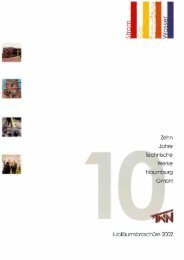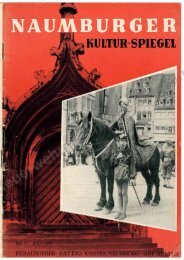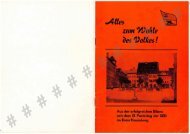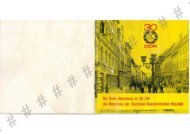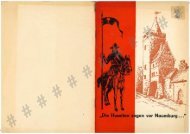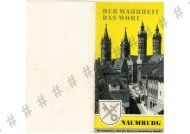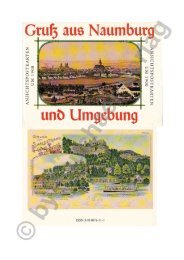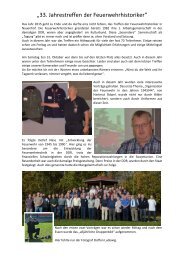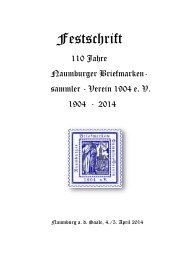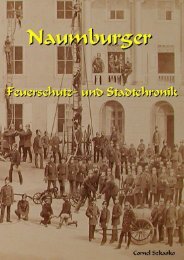- Seite 1 und 2:
INTERNATIONAL ASSOCIATION OF FIRE A
- Seite 3 und 4:
11. Sitzung der CTIF-Geschichtekomm
- Seite 5 und 6:
Kapitel 6 - Niederlande: Feuerwehrh
- Seite 7 und 8:
Vorwort des Leiters des Zentralen F
- Seite 9 und 10:
Internationale Arbeitsgemeinschaft
- Seite 11 und 12:
Für die Tagung im Jahr 1996 bittet
- Seite 13 und 14:
Die anwesenden Delegierten wählen
- Seite 15 und 16:
22
- Seite 17 und 18:
24
- Seite 19 und 20:
Was die Form der Helme anbelangt, w
- Seite 21 und 22:
Blechhenl Filzhelm Schlossfeuerwehr
- Seite 23 und 24:
Magirus plädierte damals aus Grün
- Seite 25 und 26:
Die Pickelhaube machte im Laufe der
- Seite 27 und 28:
Lederhelm, Drittes Reich, Lederhelm
- Seite 29 und 30:
6. Die Entwicklung des Feuerwehrhel
- Seite 31 und 32:
Nackenschutz Als zusätzlicher Schu
- Seite 33 und 34:
Mit Ordre vom 27. Februar 1899 wurd
- Seite 35 und 36:
ner aufgefordert, mit dem in jedem
- Seite 37 und 38:
Manchmal wurde der Adler in den Zus
- Seite 39 und 40:
46
- Seite 41 und 42:
und historische Einsatzübung in Ol
- Seite 43 und 44:
Kunststoffhelm für die Feuerwehren
- Seite 45 und 46:
Nach der Wiedervereinigung Nach der
- Seite 47 und 48:
54
- Seite 49 und 50:
Messinghelm 1873 für die Steiger b
- Seite 51 und 52:
Helmtypen und Helmbestandteilen, wi
- Seite 53 und 54:
Alle Feuerwehrkameraden waren wiede
- Seite 55 und 56:
Helmentwicklung in der städtischen
- Seite 57 und 58:
The “Brown Colony” as the Nazis
- Seite 59 und 60:
Es ist außerdem beabsichtigt, die
- Seite 61 und 62:
Bilder: Der „Frankfurter Feuerweh
- Seite 63 und 64:
70
- Seite 65 und 66:
Die Kugelhaube. Im Dialekt ihres Ve
- Seite 67 und 68:
Die “Gugelhub” Zusammenfassung
- Seite 69 und 70:
76
- Seite 71 und 72:
1864 bis 1918 So hatte die Freiwill
- Seite 73 und 74:
1918 bis 1934 Helm für Feuerwehr-O
- Seite 75 und 76:
82
- Seite 77 und 78:
1945 bis Heute In einer weiteren An
- Seite 79 und 80:
Helm in der heutigen Trageweise mit
- Seite 81 und 82:
88
- Seite 83 und 84:
zeigten. Bis auf je ein, in einer P
- Seite 85 und 86:
Alle Hahner Lederhelme tragen einte
- Seite 87 und 88:
Heute sind bei der Feuerwehr Eich n
- Seite 89 und 90:
Im Bildhintergrund zwei Feuerwehrm
- Seite 91 und 92:
98
- Seite 93 und 94:
1 2 3 4 1 Feuerwehrhelm der BF Darm
- Seite 95 und 96:
Abb. : Spritzenmannschaft mit Leinw
- Seite 97 und 98:
Durch Erlass vom 21.03.1934 wird am
- Seite 99 und 100:
Die nächste Fertigungsreihe ab 197
- Seite 101 und 102:
Nach der Veränderung der Herstellu
- Seite 103 und 104:
Plastmaterial, kamen in der Finster
- Seite 105 und 106:
submitted to the defence for the in
- Seite 107 und 108:
3. Magirus: Von der Notwendigkeit d
- Seite 109 und 110:
Württemberger Form Der Messinghelm
- Seite 111 und 112:
Dreiviertelmessingkamm, Vorder- und
- Seite 113 und 114:
Für Württemberg ergingen keine we
- Seite 115 und 116:
komplett von hinten bis nach vorne
- Seite 117 und 118:
Mit der Änderung des Stadtwappens
- Seite 119 und 120:
Behälters befindlichen Behälters
- Seite 121 und 122:
Die Stuttgarter Feuerwehrhelme von
- Seite 123 und 124: Die folgenden 60er und 70er Jahre w
- Seite 125 und 126: Mit der Forderung des Innenminister
- Seite 127 und 128: Blaues Dreieck: (inoffiziell) Alumi
- Seite 129 und 130: die erste Generation noch in einem
- Seite 131 und 132: Die Stuttgarter Feuerwehrhelme von
- Seite 133 und 134: 140
- Seite 135 und 136: Im Jahr 1908 gibt die Firma Rosenba
- Seite 137 und 138: Wir denken weiter“ … So sprach
- Seite 139 und 140: Die beiden französischen Helme der
- Seite 141 und 142: 148
- Seite 143 und 144: Bilder 3 und 4: Der traditionelle g
- Seite 145 und 146: 152
- Seite 147 und 148: „Opferdenkmal, gewidmet am 13. Au
- Seite 149 und 150: Helmvorschrift Zagreb 1882 Helmwerb
- Seite 151 und 152: 158
- Seite 153 und 154: ein paar Jahren hat man sich einsti
- Seite 155 und 156: Im Jahre 1879 führten die Varaždi
- Seite 157 und 158: Feuerwehrheims in Zagreb. (Inv. Nr.
- Seite 159 und 160: Nr. 6 Nr. 7 Nr. 8 Nr. 9 Nr. 10 Feue
- Seite 161 und 162: von französischem Muster. Man soll
- Seite 163 und 164: 170
- Seite 165 und 166: Amsterdam gibt den Ton an - nach au
- Seite 167 und 168: Amsterdam bereits das Feuerschutzpo
- Seite 169 und 170: In den Sechzigerjahren hat es ferne
- Seite 171 und 172: vorgesehen. Daraus wurde nichts: de
- Seite 173: Abb. 11 Paradehelm Amsterdamer Feue
- Seite 177 und 178: Um 1900 verfügte die Firma Glaubin
- Seite 179 und 180: 1924, Schärding 1924, Treffling 19
- Seite 181 und 182: und Überackern 1972. Nicht nur zur
- Seite 183 und 184: Bewerbsgruppe Munderfing mit Kunsts
- Seite 185 und 186: Quellenverzeichnis: Archiv der Betr
- Seite 187 und 188: Erst nach und nach setzte sich in O
- Seite 189 und 190: The aluminium helmet “Viennese fo
- Seite 191 und 192: Dieses Bild zeigt die Freiwillige F
- Seite 193 und 194: Kommandantenhelm mit breitem Schien
- Seite 195 und 196: Nach der Eingliederung Österreichs
- Seite 197 und 198: Quellenangaben: Kataloge und Prospe
- Seite 199 und 200: Chargenhelm vernickelt, FF Emblem,
- Seite 201 und 202: Helmet for Commandants, nickel-plat
- Seite 203 und 204: FF Oberwölz (nachgestellt nach ein
- Seite 205 und 206: Mannschaftshelm Helm des Zugführer
- Seite 207 und 208: Die Feuerwehr Gams ob Frauenthal er
- Seite 209 und 210: Helme der steirischen Feuerwehren -
- Seite 211 und 212: Schon seit 1859 rief der Magistrat
- Seite 213 und 214: 2. niederösterreichischen Feuerweh
- Seite 215 und 216: Laut ungarischem Uniformstatut von
- Seite 217 und 218: Eine Kombination dieser angebotenen
- Seite 219 und 220: Nach dem Anschluss Österreichs an
- Seite 221 und 222: grund der tristen wirtschaftlichen
- Seite 223 und 224: Eine Feuerwehrjugend im heutigen Si
- Seite 225 und 226:
232 Anmerkungen ( 1) Mihály Kútv
- Seite 227 und 228:
Exerziermeisterhelm Der Exerziermei
- Seite 229 und 230:
An Stelle des Kammes ist auf der Ko
- Seite 231 und 232:
isolierter Innenausstattung, aber o
- Seite 233 und 234:
Die Helme der Wiener Berufsfeuerweh
- Seite 235 und 236:
242
- Seite 237 und 238:
Links Feuerwehrmitglied Adrian, FF
- Seite 239 und 240:
AGV Sturzhelm mit Visier von der Gr
- Seite 241 und 242:
der Flugdienst im Bereich der Einsa
- Seite 243 und 244:
DRÄGER Waldbrandhelm, Farbe gelb,
- Seite 245 und 246:
252
- Seite 247 und 248:
Kappen wie bei der k. u. k. Kriegsm
- Seite 249 und 250:
zum Preis von 1,5 bis 2 Kronen an.
- Seite 251 und 252:
• Man kam zu diesem Ergebnis: •
- Seite 253 und 254:
Heros mit Atemschutzmaske und Lampe
- Seite 255 und 256:
ein Rüstungsbetrieb, der für die
- Seite 257 und 258:
FF Stadt Salzburg im Jahr 1867 Die
- Seite 259 und 260:
oft aus der Vereinskasse oder von d
- Seite 261 und 262:
Nach wie vor werden von den Feuerwe
- Seite 263 und 264:
In der am 9. November 1989 beschlos
- Seite 265 und 266:
Festaufmarsch der FF Adnet im Jahr
- Seite 267 und 268:
Im Land Salzburg getragene Feuerweh
- Seite 269 und 270:
The members had to finance their un
- Seite 271 und 272:
Als Erkennungszeichen für den Komm
- Seite 273 und 274:
280
- Seite 275 und 276:
Uniformen und Helme der Warschauer
- Seite 277 und 278:
der Feuerwehrgeräte informierten d
- Seite 279 und 280:
Bild 11 Bild 12 Bakelithelm um 1960
- Seite 281 und 282:
d. h. Proben der Durchschlagfestigk
- Seite 283 und 284:
290 wurden auch neue Feuerwehrabzei
- Seite 285 und 286:
Helme der Feuerwehr Basel 1845-1990
- Seite 287 und 288:
Leder-Helm für die Feuer- Messing-
- Seite 289 und 290:
Helme der Feuerwehr Basel, 1845-199
- Seite 291 und 292:
Kopfschutz für den Feuerwehrmann i
- Seite 293 und 294:
Der Autor mit dem Kommandantenhelm
- Seite 295 und 296:
Zur Zeit sind die Berufsfeuerwehren
- Seite 297 und 298:
Feuerschutzhelme in Slowenien Vili
- Seite 299 und 300:
Bilder der Feuerschutzhelme aus Ža
- Seite 301 und 302:
Da Kunststoff im alltäglichen Lebe
- Seite 303 und 304:
wird nach einer besonderen Technolo
- Seite 305 und 306:
Feuerschutzhelme in Slowenien Zusam
- Seite 307 und 308:
Feuerschutzhelme in Böhmen und Mä
- Seite 309 und 310:
militärische Helme, die aus den Mi
- Seite 311 und 312:
Die Schale ist aus plastischem Stof
- Seite 313 und 314:
Lederhelm mit den Metallenschildern
- Seite 315 und 316:
Militärmetallhelm französischem T
- Seite 317 und 318:
Von den Helmen zur Offizierskappe (
- Seite 319 und 320:
5. Das große Hindernis war das ste
- Seite 321 und 322:
Geschichte lebt von Geschichten - Z
- Seite 323 und 324:
Dokumentationsgrundlage dinglicher
- Seite 325 und 326:
Bereits verstorbene Zeitzeugen Das
- Seite 327 und 328:
schaulich die Geschichte ihres Feue
- Seite 329 und 330:
waren meine ersten einschneidenden
- Seite 331 und 332:
manuell anschieben, weil sie nicht
- Seite 333 und 334:
hen, dass ich irgendetwas anziehen
- Seite 335 und 336:
Geschichte lebt von Geschichten - Z
- Seite 337 und 338:
Autoren 2008 Hans-Joachim AUGUSTIN,
- Seite 339 und 340:
Djuro GAJDEK, Sisak, Kroatien * 194
- Seite 341 und 342:
Veröffentlichungen feuerwehrgeschi
- Seite 343 und 344:
ZwF Zeitschrift für Wirtschaftlich
- Seite 345 und 346:
Peter RONEC, Ing., Pezinok, Slowaki
- Seite 347 und 348:
Peter SNELLEN, Eindhoven, Niederlan
- Seite 349 und 350:
Alois VLACIL, Olsany u Prostejova,
- Seite 351 und 352:
Tagungsthemen und Autorenverzeichni
- Seite 353 und 354:
GAJDEK, Dipl. jur. Djuro, Kroatien
- Seite 355 und 356:
2007 Die Feuerwehrzeitungen aus dem
- Seite 357 und 358:
2006 Reginald Czermack 2007 Zeitsch
- Seite 359 und 360:
2007 Hessen, ein feuerwehrhistorisc
- Seite 361 und 362:
2005 Bericht über die Zusammenarbe
- Seite 363 und 364:
2007 Die Württembergisch-Hohenzoll
- Seite 365 und 366:
381
- Seite 367 und 368:
383
- Seite 369 und 370:
385
- Seite 371:
Kapitel 6 - Niederlande: Feuerwehrh





